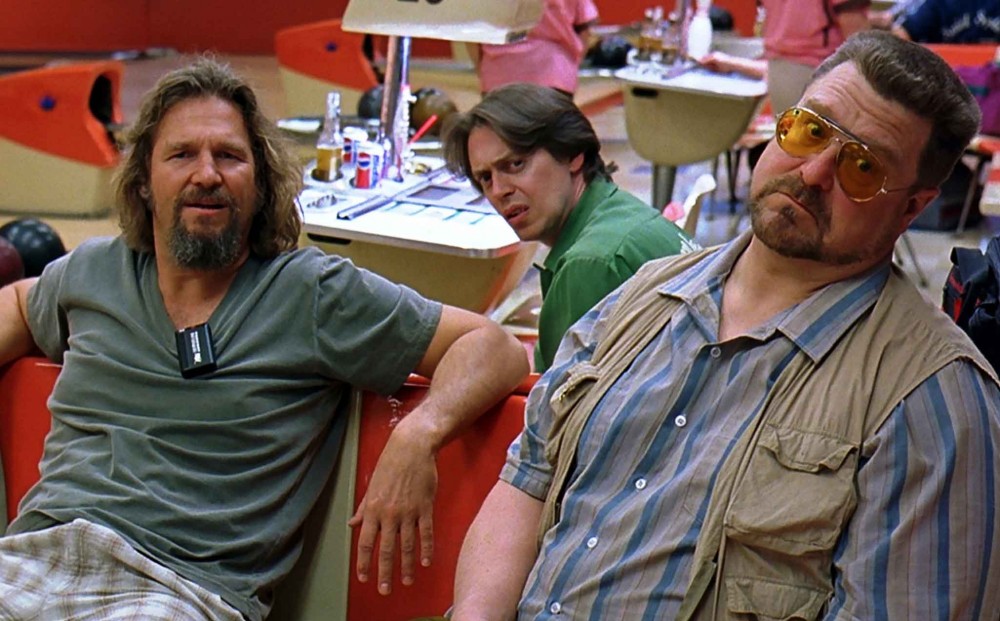THE BIG LEBOWSKI & THE LAST PICTURE SHOW
Tuesday, September 5
THE BIG LEBOWSKI
12:30 5:10 9:50
THE LAST PICTURE SHOW
2:45 7:30
THE BIG LEBOWSKI
Directed by Joel Coen & Ethan Coen
Starring Jeff Bridges & John Goodman
(1998) “This is not ‘Nam. This is bowling. There are rules.” Stoner and avid bowler Jeff “the Dude” Lebowski (Jeff Bridges) can’t figure out who soiled his Persian rug and why (“it really tied the room together”) but – egged on by his gung-ho Vietnam vet buddy Walter (John Goodman) – he winds his way through Los Angeles in search of answers, leading him to another, girthier Lebowski (David Huddleston), his nymphomaniac wife (Tara Reid) and unctuous assistant (Philip Seymour Hoffman), a performance artist (Julianne Moore), a porn emperor (Ben Gazzara), and a band of German nihilists. With Steve Buscemi as the Dude’s clueless pal Donnie and John Turturro as a purple-clad bowling champ named Jesus. 35mm. Approx. 117 min.
12:30, 5:10, 9:50
“Immensely inventive and entertaining… a prime example of the Coens’ effortless brand of stylistic and storytelling brilliance. Thanks to Roger Deakins’ gleaming camerawork, T-Bone Burnett’s eclectic soundtrack selection and the Coens’ typically pithy dialogue, it looks and sounds wonderful. Moreover, far from being shallow pastiche, it’s actually about something: what it means to be a man, to be a friend, and to be a ‘hero’ for a particular time and place.”
– Geoff Andrew, Time Out
“A cubist comedy concocted by the irrepressible Coen brothers out of bits and pieces of the old and the new, the black and the blue, the profound and the profane, in a portion of Los Angeles where hyper-reality collides with hyper-gaucherie.”
– Andrew Sarris, New York Observer
“Soon after the Gulf War filled the airwaves with such Orwellian obscenities as ‘collateral damage,’ the Coen brothers, Joel and Ethan, tuned into the martial mood and rummaged through political and personal history for the underpinnings of this Los Angeles caper, from 1998, sending up, with rueful astonishment, the American way of war.”
– Richard Brody, The New Yorker
THE LAST PICTURE SHOW
Directed by Peter Bogdanovich
(1971) 1951 in windswept Anarene, Texas, Father of the Bride is playing at the Royal Theater, the football team has wrapped up another crummy season, and pals and teammates, sensitive Timothy Bottoms and boisterous Jeff Bridges, along with mute, endlessly sweeping hanger-on Sam Bottoms, are already starting off the day at Ben Johnson’s pool hall. Or scarfing cheeseburgers at Johnson’s diner, presided over by Eileen Brennan, or riding in Bridges’ girlfriend Cybill Shepherd’s convertible, as Shepherd’s dissatisfied mom Ellen Burstyn flips the bird at her arrogant occasional lover and lonely, depressed coach’s wife Cloris Leachman waits for that weekly ride to the doctor. Elegy for a dying small town — its “last picture show” is Hawks’ Red River (“apparently programmed by the Texas correspondent of Cahiers du Cinéma” – Dave Kehr) — and coming-of-age story, but also chronicle of multiple couplings in a town with no secrets (Shepherd, then a model with no acting experience, effortlessly incarnates a cluelessly entitled beauty who tantalizes five different swains), Picture Show was shot on location in novel author/co-scenarist Larry McMurtry’s own home town, unusually in black and white (a suggestion of Bogdanovich house guest Orson Welles). Oscar nominations for Best Picture, Director, Screenplay, Cinematography, and a never-topped four for supporting parts (Bridges, Johnson, Leachman, Burstyn), with wins for Leachman and Johnson, who turned the part down three times before John Ford talked him into it. DCP. Approx. 118 min.
2:45, 7:30
“In an unbroken arc of narrative, beautifully photographed (by Robert Surtees) in the blunt, black-and-white tones I associate with pictures in a high school yearbook, tells a series of interlocking stories of love and loss that are on the sentimental edge of Winesburg, Ohio, but that illuminate a good deal more of one segment of the American experience than any other American film in recent memory.”
– Vincent Canby, The New York Times
“Plain and uncondescending in its re-creation of what it means to be a high school athlete, of what a country dance hall is like, of the necking in cars and movie houses, and of the desolation that follows high school graduation.”
– Pauline Kael
“The best film of 1951, you might say. Using period songs and decor to create nostalgia is familiar enough, but to tunnel down to the visual level and get that right, too, and in a way that will affect audiences even if they aren’t aware how, is one hell of a directing accomplishment... I wonder if Bogdanovich’s film doesn’t at last explain what it was that Pauline Kael, and a lot of the rest of us, lost at the movies.”
– Roger Ebert


